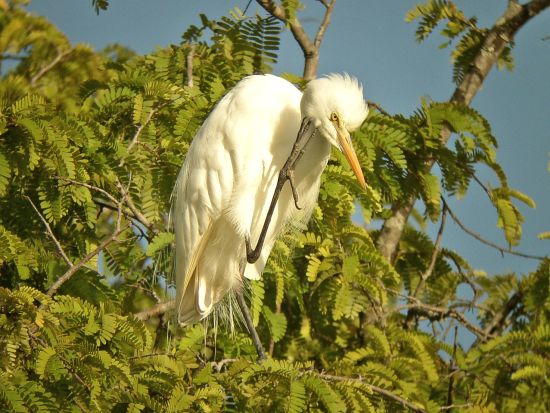Alternative Name(s): Intermediate Egret
- Ardea plumifera
Mesophoyx intermedia
Egretta intermedia
Identification
56–72 cm (22-28 in). Medium-sized white egret.
- all white
- bill relatively short (medium), robust
- gape does not extend beyond eye
- neck generally without pronounced kink (or reduced compared with Great Egret)
- head rounded
Nonbreeding:
- bill yellow
- legs black below 'knee': yellow, grey or reddish above
- Possibly wisps of fine breast plumes
Breeding
- Long filmy, erectile plumes on back and breast
- Orange-red bill
- Bluish facial skin
- Tibia yellow
Similar Species
Most similar to Great Egret, especially in parts of south-east asia (Great Egret subspecies modesta). Plumed Egret differs as follows:
- smaller, daintier, more graceful with extended head and neck about equal to body length
- line of gape extends to just below eye (Great Egret's extends well past it)
- head is rounder
- bill shorter and deeper (around 1-1.5x head length cf 2x for Great). The shorter bill also gives Intermediate's head a more triangular look than the attenuated snake-like head of Great Egret
- feathered chin of Intermediate extends farther forward along the lower mandible
- adult Plumbed usually has longer plumes on the breast
- Plumed tends to be in more vegetated, marshy sites
- (Plumed frequently has a less pronounced neck kink than Great. However, this character is not failsafe: an egret without a link is likely Plumed but one with one may not be Great)
You can confuse Plumed non-breeding with non-breeding Eastern Cattle Egret. The latter:
- is significantly smaller (where this is possible to judge). The largest Eastern Cattle Egrets are around 85% of the smallest Intermediates
- is more squat with a proportionately shorter neck
- has facial skin the same colour as its bill (usually a different, paler yellow in Plumed)
- has throat and chin feathering which extends further along the lower mandible than in Plumed
- is more round-headed in appearance with a "deeper" head
- shows less tibia above the "knee" than Plumed
- lacks the more extensive diaphanous plumes hanging from Plumed's scapulars and breast (may be difficult to see)
Distribution
Southern New Guinea, eastern Indonesia and Australia mainly in the north and east. Australian birds may undergo migratory movements and may occur in New Guinea only in winter.
Taxonomy
Formerly considered a race of "Intermediate Egret", A. intermedia but now recognized as a full species. Formerly placed in Egretta or in Mesophoyx, however, most authorities now agree on Ardea.
Subspecies
This is a monotypic species[1].
Habitat
Freshwaters, including slow-flowing rivers, lakes and swamps, also coastal mudflats and mangroves, sometimes grassland.
Behaviour
Breeding
Breeds in colonies, often with other species of herons/egrets.
Diet
Their diet consists of smaller fish, eels, frogs, snakes and insects.
References
- Clements, J. F., P. C. Rasmussen, T. S. Schulenberg, M. J. Iliff, T. A. Fredericks, J. A. Gerbracht, D. Lepage, A. Spencer, S. M. Billerman, B. L. Sullivan, and C. L. Wood. 2023. The eBird/Clements checklist of Birds of the World: v2023. Downloaded from https://www.birds.cornell.edu/clementschecklist/download/
}#Handbook of the Birds of the World Alive (retrieved July 2015)
- BF Member observations
- Eaton, JA, B van Balen, NW Brickle, FE Rheindt 2021. Birds of the Indonesian Archipelago (Greater Sundas and Wallacea), Second Edition. Lynx Editions. ISBN978-84-16728-44-2
Recommended Citation
- BirdForum Opus contributors. (2025) Plumed Egret. In: BirdForum, the forum for wild birds and birding. Retrieved 16 May 2025 from https://www.birdforum.net/opus/Plumed_Egret
External Links
GSearch checked for 2020 platform.




